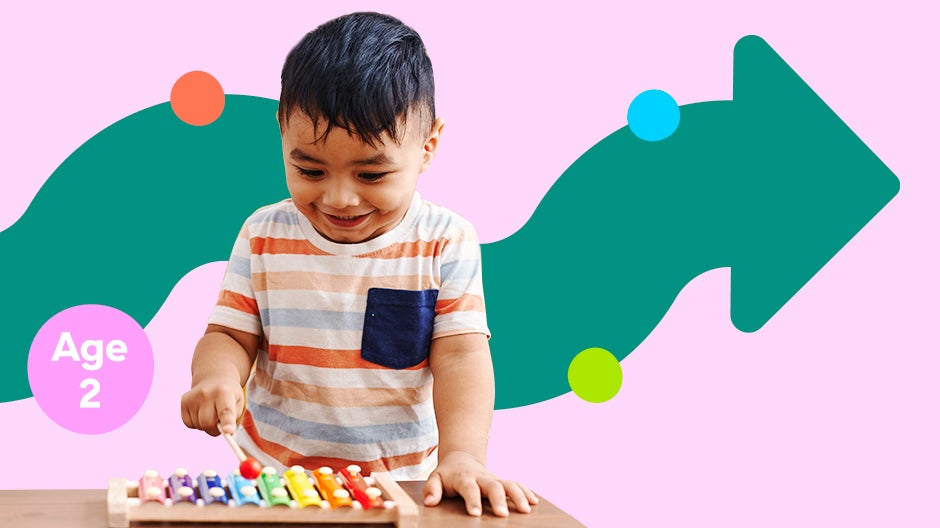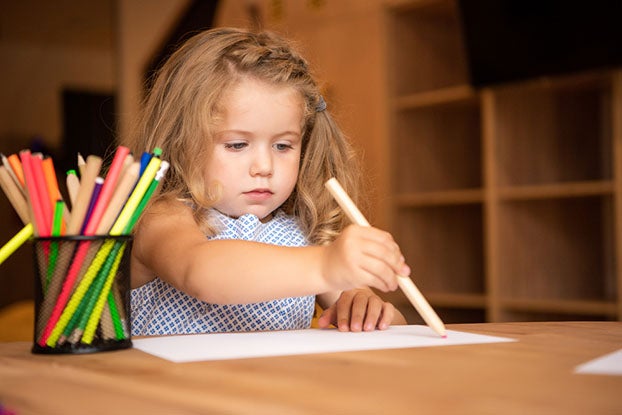Two-year-olds are in an incredibly rapid time of change and development. Their brains are growing fast, and almost everything they see, hear, smell, taste, and touch is new for them, meaning new neural connections are being formed at astonishing rates.
At Begin, we know that your child is more than just neurons. Kids are unique, multifaceted, and have limitless potential. Because our mission is to give every child their best start, the Begin Approach to early learning focuses on a broad set of skills critical for school and life success. We’ve simplified those skills into 5 C’s: Creativity, Critical Thinking, Curiosity, Character, and Core Skills.
So what do developmental milestones in those C’s look like for your 2-year-old? Let’s take a look!
The Short Cut
- 2-year-olds are developing important skills that will help them learn throughout their lives
- The 5 C’s that lead to thriving in school and life are Creativity, Critical Thinking, Curiosity, Character, and Core Skills
- For 2-year-olds, the 5 C’s can be supported through play and simple everyday interactions
- Parents can help 2-year-olds develop the 5 C’s by modeling skills like how to hold a book, how to group objects by color or function, how to recognize and name feelings, and how to count objects
Creativity
Creativity is a child’s ability to come up with solutions to problems, invent new ideas, and express themselves in novel ways. Most young children are naturally creative, and chances are your child is no exception! Our job as parents and caregivers is to foster that creativity throughout their childhood to help them become creative adults.
Your 2-year-old’s creativity might look unexpected, such as coming up with solutions to obstacles they face in their everyday lives. If you’ve ever seen them find an object to stand on so they can reach a snack from the kitchen counter, that’s creativity! You may also see the emergence of pretend play, like when your child uses a banana to pretend it’s a phone. In this example, she’s creatively using one thing to substitute for another. That’s the root of symbolic understanding, critical for learning to read and comprehend other symbol systems, like pluses and minuses in math.
Critical Thinking
Critical thinking includes two elements: the ability to make decisions and analyze information, and a broad set of processing skills often referred to as executive functions. These skills lay the foundation for making good decisions, understanding rules and consequences, and identifying trustworthy information versus untrustworthy information. This might sound lofty considering we’re talking about toddlers, but you’ve probably already seen these skills in action!
Before age 3, your child will likely start to group objects by a feature such as color (all the blue things) or function (all the toy cars versus all the toy animals), or even arrange them in an orderly fashion. This shows that your child is starting to pay attention to details, patterns, and ways in which things operate in the world—all part of developing more advanced critical thinking skills later.
Another element of critical thinking is your child’s ability to remember a request for a few minutes, even with some distractions around. For example, if you ask your child to go to the other room and bring back a book, she can remember what she’s looking for and avoid picking up an exciting toy instead. Both of those abilities demonstrate developing executive functioning skills.
Curiosity
This one probably feels obvious! Toddlers are experts at asking “how” and “why,” and those questions are some of their primary tools for understanding the world around them. At this stage, so much of what they encounter on a daily basis is still new to them, so most 2-year-olds are naturally curious.
Beyond asking questions, toddlers are often in full scientific exploration mode, experimenting with objects through play. You may observe your child putting things in and out of containers repeatedly (to test whether they continue to exist even when they’re out of sight, and how different sizes and shapes fit together), or even hitting you to see what happens (this one is less fun).
Curiosity is essential for developing a lifelong love of learning, and you can help your child develop it by encouraging them to explore and ask questions, and to see what they’re naturally interested in.
Some children in this age range begin to develop deep interests in things like dinosaurs, stars, trains, and more. This is great! It gives you a hook to help teach them other things like colors, counting, and pre-reading skills. When children are intrinsically motivated to learn, which they are when they’re diving into a subject they’re curious about, they tend to learn more quickly and more deeply than if we try to teach them in ways that aren’t in line with their passions.
Character
Children who develop Character, or social-emotional skills, in their early years tend to do better in school and life, including having more positive relationships with teachers and friends. Yet this one can feel tricky for parents, especially if you’re experiencing what so many refer to as the “terrible twos” (for the record, at Begin we don’t think any stages are terrible. Some days—and hours, and minutes, and seconds—are harder than others though).
At age 2, your child should be learning to name her emotions so that she can communicate how she’s feeling to others. She’ll also start recognizing emotions in others based on their facial expressions, body language, and words. Being able to recognize and name others’ emotions is the basis for empathy and other foundational friendship skills.
You may notice that your child plays beside other children and not necessarily with them. That is completely normal for this age group. It might also be hard for your child to share toys and take turns. We expect this in toddlers too! Your child may be looking to you to see how to react in new situations, and you can use this opportunity to model feelings vocabulary (“That little boy is crying because he is really sad right now. Do you know what might make him happy?”) and reactions (offering the boy a toy or smiling to cheer him up).
Core Skills
While it may be a few years before your 2-year-old is reading and doing math, there are some really important foundational learning skills being developed at age 2 that are critical for later success.
In terms of language and literacy, children are developing vocabulary, background knowledge, and pre-reading skills like how books work. They’re also beginning to understand that words on a page represent ideas and images, and that words are constant and convey meaning. There’s a large body of research demonstrating the importance of talking, singing, and reading to your child from the earliest ages, and your toddler will continue to benefit from these activities.
Although every child develops differently, most 2-year-olds should be using at least 50 words and using two-word phrases. If you’re ever in doubt about your child’s development, you should speak with your child’s health care provider.
In addition to learning and using more words through play, toddlers can learn early math skills through play as well. For example, while your toddler is stacking blocks, you can ask them how many blocks they have (object counting, which may not be present or very accurate yet), which ones are bigger or smaller (size comparisons and measurement), and which ones are on top or behind (spatial reasoning). If they haven’t learned these skills yet, demonstrate them yourself—they’ll likely start to mimic you eventually!
This kind of learning through play can be a lot of fun for you and your child. It’s adorable and exciting to watch your 2-year-old count their blocks “One, two, two, four, nine,” and the smile on your face when they do will encourage them to keep experimenting with numbers and math as they grow.
Learning Begins with Play
As you can see, there is a LOT going on during the toddler stage, and everything we’ve described above begins with—and continues to be supported by—play.
To learn more about your 2-year-old’s development and how to help them across the 5 C’s (or see what comes next at age 3!), check out our other parent resources.













